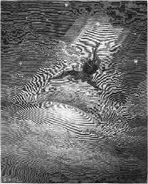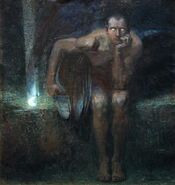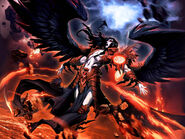- This article is about the fallen angel. For Roman deity or spirit of the same name, see Lucifer (genius).
Lucifer is the Latin term used for the Hebrew word הֵילֵל (Hêlēl) in Latin and English translations of the Hebrew Bible.[1] The term is used in a verse describing the downfall of the King of Bablyon in Isaiah 14:12.[2]
Over time, the verse has been commonly interpreted by mainstream Christian denominations as also representing the downfall of Satan from heaven.[2][3][4] This is due to a false etymology of Hêlēl found in the Syriac (a dialect of Aramaic) version of the Bible, where Hêlēl is thought to be derived from the verb "yalal," meaning "to lament."[2] With this interpretation, the epiphet "Lucifer" is used to denote Satan's status as a fallen angel,[2] and is particularly associated with the idea that Satan's first sin was that of pride,[3]
The figure of the demon Lucifer is also found within Islam, though he is not thought of as synonymous with the figure of Satan. In Islam Lucifer is associated with the sin of wrath and was thought to have been formerly called Azazil or Uzayzil prior to his downfall.
Etymology[]
The Hebrew term Hêlēl is used Book of Isaiah 14:12 as an epiphet for the king of Babylon. Meaning "Shining One,"[1] the term is meant to liken the King of Babylon's brilliance to the brightness of the planet Venus, the morning and evening star, in the night sky.
In the Septuagint (the Greek translation of the Hebrew Bible) Ἑωσφόρος (heōsphoros), the Greek term for the planet Venus was used, from the terms "Héōs," meaning "dawn" and "phérō," meaning "to bear or carry."[5]
From heōsphoros, the Latin term for the planet Venus, lucifer, was used, from the terms "luc-," meaning "light," and "ferre," meaning "to bear or carry."[4]
Lucifer in the Hebrew Bible[]
The primary passage that's used to reference Lucifer in the Hebrew Bible is the Book of Isaiah 14:12. In this verse, the downfall of the king of Babylon is described. This passage is also thought by many Christians to mirror or represent the fall of Satan from heaven as Lucifer:
| “ | 12 How you are fallen from heaven, O Day Star*, son of Dawn! How you are cut down to the ground, you who laid the nations low! -Isaiah 14:12 (New Revised Standard Version)[6] |
” |
Here the term "Day Star" is translated as "Lucifer" in older translations such as the King James Translation.[7] Day/Morning Star is a name for the planet Venus.
The passage continues, describing the King of Babylon's immense pride that lead him to strive to be higher than God himself, and how this pride ultimately lead to his failure. Again, this continuation of the passage is thought by Christians to either mirror or represent Lucifer and his pride that lead him to rebel against God:
| “ | 13 You said in your heart, “I will ascend to heaven; I will raise my throne above the stars of God; I will sit on the mount of assembly on the heights of Zaphon; 14 I will ascend to the tops of the clouds, I will make myself like the Most High.” 15 But you are brought down to Sheol, to the depths of the Pit. -Isaiah 14:13-15 (New Revised Standard Version)[8] |
” |
Lucifer as Satan in the New Testament[]
Christian Bibles do not explicitly state that Lucifer and Satan are the same individual, but rather, various individual passages are interpreted together with Isaiah 14:12 to justify the concept. One such passage is found in the Book of Luke 10:18:
| “ | He (Jesus) said to them, “I watched Satan fall from heaven like a flash of lightning..."
-Luke 10:18 (New Revised Standard Version)[9] |
” |
In the passage above, Jesus says that he saw Satan fall from heaven, echoing how Lucifer is said to have fallen from heaven. Because of the similarity, many Christian denominations interpret Isaiah 14:12 and Luke 10:18 to be referencing the same event.[3]
One of the most detailed accounts of Satan falling from heaven is found in The Book of Revelation 12:7-9. Like Luke 10:18, this verse is interpreted by a majority of Christian denominations as describing the same event as Isaiah 14:12:[3]
| “ | 7 And war broke out in heaven; Michael and his angels fought against the dragon. The dragon and his angels fought back, 8 but they were defeated, and there was no longer any place for them in heaven. 9 The great dragon was thrown down, that ancient serpent, who is called the Devil and Satan, the deceiver of the whole world—he was thrown down to the earth, and his angels were thrown down with him.
-Revelation 12:7-9 (New Revised Standard Version)[10] |
” |
In the quote above, the dragon in Revelation is said to be the same figure as the snake in the Garden of Eden ("that ancient serpent"), the Devil, and Satan. By extension, since Lucifer and Satan are interpreted as being synonymous with one another, Lucifer is interpreted as being one-and-the-same with the figures listed in the quotation as well.
Another quotation, by the Apostle Paul in his second letter to the Corinthians, when discussing the issue of false prophets, states that Satan disguises himself as an angel of light:
| “ | 13 For such boasters are false apostles, deceitful workers, disguising themselves as apostles of Christ. 14 And no wonder! Even Satan disguises himself as an angel of light. 15 So it is not strange if his ministers also disguise themselves as ministers of righteousness. Their end will match their deeds.
-2 Corinthians 11:13-15 (New Revised Standard Version)[11] |
” |
The notion that Satan can disguise himself as an angel of light is interpreted as being related to the idea of Lucifer as the "Shining One," of "Bearer of Light."[12]
Lucifer in the Dictionnaire Infernal[]
Throughout history multiple formalized classifications of demons have been proposed. None of them however are considered canon by modern mainstream Christian denominations. Instead, lists of formalized demonologies tend to remain popular in occult traditions. The Infernal Dictionary is a book of demonology written in 1818 by the French occultist Jacques Auguste Simon Collin de Plancy. The entry for Paimon (Paymon) is as follows:
| “ | Lucifer, name of the spirit that presides over the East, according to the opinion of the magicians. Lucifer was evoked on Monday, in a circle in the middle of which was his name. He contented himself with a mouse as the price of his kindness. He is often taken for the king of hell, and, according to some demonomams, he is superior to Satan. It is said that he is sometimes facetious, and that one of his tricks is to take away the broomsticks on which the witches go on the sabbath and put them on their shoulders; what the witches of Moira, in Sweden, attested in 1672. The same witches confirmed that they had seen at the Sabbath the same Lucifer in a gray coat, with blue stockings and red breeches, adorned with ribbons. Lucifer commands Europeans and Asians. He appears in the form and figure of the most beautiful child. When he is angry, his face is inflamed, but nothing monstrous. He is, according to some demonographers, the great vigilante of the underworld. He is invoked first in the Sabbath litanies.[13] | ” |
Gallery[]
Videos[]
See also[]
References[]
- ↑ 1.0 1.1 https://biblehub.com/hebrew/1966.htm
- ↑ 2.0 2.1 2.2 2.3 https://www.newadvent.org/cathen/09410a.htm
- ↑ 3.0 3.1 3.2 3.3 https://www.stgeorgegreenville.org/our-faith/angels/fallen-angels
- ↑ 4.0 4.1 https://www.etymonline.com/word/lucifer
- ↑ https://en.wiktionary.org/wiki/Eosphorus
- ↑ https://www.biblegateway.com/passage/?search=Isaiah+14%3A12&version=NRSV
- ↑ https://www.biblegateway.com/passage/?search=Isaiah%2014%3A12&version=KJV
- ↑ https://www.biblegateway.com/passage/?search=Isaiah+14%3A13-15&version=NRSV
- ↑ https://www.biblegateway.com/passage/?search=Luke+10%3A18&version=NRSV
- ↑ https://www.biblegateway.com/passage/?search=Revelation+12%3A7-9&version=NRSV
- ↑ https://www.biblegateway.com/passage/?search=2%20Corinthians%2011:13-15&version=NRSV
- ↑ https://www.britannica.com/topic/Satan
- ↑ https://upload.wikimedia.org/wikipedia/commons/e/e0/Jacques_Collin_de_Plancy_-_Dictionnaire_infernal.pdf












